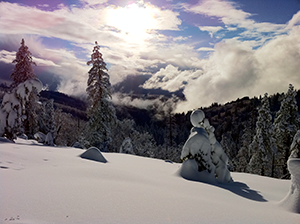New Study Finds Dust/Biological Particles Traveling from Sahara and Asia Influence Precipitation on West Coast

Sierra Nevada Mountains (Photo credit: Jessie Creamean, CIRES)
|
February 28, 2013
A new study led by the University of California, San Diego (UCSD) and NOAA's Earth System Research Laboratories (ESRL) has found that dust and biological aerosols from the Sahara and Asia journey across the Pacific Ocean and eventually influence the formation of precipitation falling on the West Coast of the U.S.
This study, recently published in Science, is part of a larger field experiment called CalWater, which seeks to understand heavy precipitation events and how precipitation could change in a changing climate. The aerosol study is a major focus of CalWater because of the potential of these particles to affect cloud formation and precipitation.
A team of scientists began analyzing clouds over California's Sierra Nevada Mountains, and the rain and snow on the ground below. They wanted to find out what aerosols are seeding the clouds, and if those same aerosols exist in the precipitation coming from them. Their analysis led to some unexpected discoveries.
"One of the big surprises from our study was that some of the dust came all the way from the Sahara Desert," said lead author, Jessie Creamean, a postdoctoral associate working at ESRL's Physical Sciences Laboratory. This is especially interesting since Saharan dust has been primarily observed to travel westward over the Atlantic Ocean, not eastward.
"When it's lofted really high," said Creamean, "The dust gets caught in wind patterns that transport it across Asia and the Pacific."
Other aerosol studies have focused solely on eastbound particles originating from Asia. Using satellite data, the team was able to follow the dust's journey from Africa, and continuing over Asia and the Pacific. Once the aerosols reach the U.S. west coast, they seed clouds by forming ice crystals, which fall as rain or snow.
Another unique finding in this study is that biological particles (such as bacteria, pollen, spores and leaf particles) are among the aerosols that are picked up and moved by the jet stream.
"A lot of people haven't thought of biological particles as being globally significant in forming cloud ice," said Creamean. "We were able to show that they do play an important role in precipitation-forming processes."
With the water cycle in California often swinging between too much and too little water (floods and droughts), aerosol data could become a critical piece of information for water resource decision makers, especially in terms of water availability and hydroelectric power.